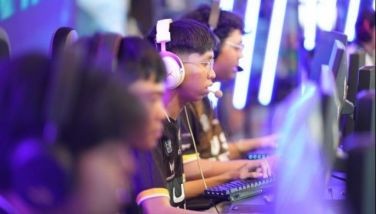Pyrographer

At 26, Edison Filaro Billones has mastered pyrography, or “painting with fire.”
In Greek, “pyro” means fire while “graphos” means art. Pyrography, then, is the art of using fire or heated metal to burn wood or paper surfaces in various depths, and thus render a visual image or picture.
Edison uses a modified soldering iron to create his “masterpieces,” which fetch him modest prices. Most of his works are commissioned, although he takes pains to initiate his own interpretations of mythic or heroic images, mostly of the comic book variety.
I heard of his outstanding works when he was invited to lecture and demonstrate his art, or craft, before an Ateneo students’ group. The kids were wowed by his obvious skills and oeuvres, which have also been on display for some time at his website, www.burning inkworks. deviantart.com.
I invited Edison to meet with me, and had him guest on my Talk News TV show on Monday nights (8:45-9:30 p.m.) on GNN Channel 3 of Global Destiny cable. As it had happened in Ateneo, all the cameramen and studio personnel wound up crowding around his works and marveling at them, asking for this or that item’s price. These ranged from large wood panels on which iconic figures such as of the Justice League of Super Heroes have been burned in, with superb detailed finish, to sundry gift items incorporating pop text.
 As Edison explains in his website, which is also accessible via multuiply.com, “A great range of effects, tones and shades may be achieved in burning on natural surfaces.”
As Edison explains in his website, which is also accessible via multuiply.com, “A great range of effects, tones and shades may be achieved in burning on natural surfaces.”
He adds: “Subtle or bold effects may be achieved depending on many factors, including heat, pressure, the type of wood or surface and the tips used (for the soldering iron). Every stroke is drawn entirely by hand, making each piece unique.”
Edision graduated from the Parañaque National High School, and couldn’t get into college for lack of funds. He went to work as a janitor at a recruitment agency, then as a houseboy and a warehouse helper, before becoming a freelance artist.
This decision came about when an older friend of his stumbled into pyrography. It drew his interest. Together they scoured the Internet, and saw how Western artists utilized costly implements to practice the special genre. Edison’s friend came up with a simple device, using a cheap soldering iron that cost less than 200 pesos. With Edison’s inherent ability at draftsmanship, honed by illustrating comic books, he found that he could translate these skills into “burning ink.”
He’s also been indefatigable in his research on the “deviant art.” To my surprise, he had heard of the “solar art” practiced in Baguio, which was started by the late lamented Santiago Bose, and which now finds a masterful adherent in Jordan Mang-osan. The sun’s rays are used to burn through a magnifying lens upon paper, sometimes even on wood. It requires a lot of patience, and of course, strong sun.
For his part, Edison has also found out about a related craft, that of using a scroll saw to produce segmented works, where layering is achieved by gluing the intricately cut pieces together, then applying paint.
This genre allows the young man to produce varied works, which range from a three-dimensional Incredible Hulk in authentic green to Pirates of the Caribbean figures embossed on a vertical panel with a clock worked in (as a utilitarian household item), as well as keychain pieces, gift boxes, and assorted souvenir-type items.
But it’s in his pyrography where he triumphs with design and artistic application, utilizing his drawing skills to the full before these are enhanced with the delicate fire-painting. Light-colored wood like balsa or palo china works best, he says, as the burned lines and shades stand out in contrast. He’s also learned to take cognizance of natural wood grains and whorls, and somehow incorporate these into his portraits.
 For now, Edison’s subjects reflect his youth and interests, from heroes like Wolverine to other trendy characters such as the Twilight couple. I told him that a variety of burned portraits of Barrack Obama would sell quite well, maybe even earn him international fandom, let alone an expanded clientele. The same may be said of Manny Pacquiao products for locals and balikbayans.
For now, Edison’s subjects reflect his youth and interests, from heroes like Wolverine to other trendy characters such as the Twilight couple. I told him that a variety of burned portraits of Barrack Obama would sell quite well, maybe even earn him international fandom, let alone an expanded clientele. The same may be said of Manny Pacquiao products for locals and balikbayans.
I commissioned him to make a flying-dunk portrait of LeBron James, which I could then present as a jpg file to the Cavs Nation e-forum. Why, maybe as Edison Billones’ agent, I could start making something like a millionth of the mint that the subject rakes in annually.
Other ideas include large-scale pyrograph murals, or sidings wrapping up a bar counter, room dividers, wooden chests, hanging mobiles, totem-like poles from felled logs. But of course Edison has to either clone himself or start a veritable cottage industry by taking a corps of barangay kids under his wing, and training them in the deviant art he excels in.
Already some pyrographers in the US have noted Edison Billones’ work, and expressed amazement at how he manages to produce gradated shades, when their own works are mostly beholden to the principles of stark chiaroscuro. And they can’t quite believe that Edison’s art relies only on the cheapest of soldering irons, with the modified tips serving as the crucial tools.
But is it art? Decidedly, at this point it’s more of a craft, unless Edison begins to first copy acknowledged masterpieces like the “Mona Lisa” or “Guernica” and “Spoliarium.” Even then, the painstaking work might only earn merit for him as a derivative artist. He’d have to be fashionably witty and conceptually clever like Andy Warhol to elevate his copies into statement chic. Or maybe he can just go ahead and create his own fresh and original images.
There’s always been a question as to when a creative work is classified as craft or art, low or high. I still treasure a small wooden treasure box someone gifted me with in my youth, made in the Iwahig penitentiary, but obviously with much love by the craftsman who inlaid mother-of-pearl designs in fine geometric patterns on the burnished kamagong. I continue to find it lovely, a work of art.
Yet there remains that conundrum — involving artisanship, folk tradition, indigene heritage, cottage industry manufacture, and questions of kitsch — that leads to a pigeonholing of creative artists. Such that the woodcarvers of Betis or the gamelan players of southern Mindanao, at their best, can only hope to be declared as National Treasures, almost always as an afterthought.
This is no complaint. Such is the boxing-in or labeling that applies practical and easy categorization, given the wide spectrum of creative expression. It creates its own demographic.
No matter. Individuals like Edison Billones have to be commended for contributing to the array of delights in their own way, as much as for providing an example for out-of-school youth, indeed for all idlers who can tap their time and possible talent. His kind will not content themselves with snatching cellphones or burning down cell sites as ideological rebels. Rather would they snatch the mythic fire, play with it, and illustrate Spiderman as an act of romancing wood. Thus self-empowered, they assume great responsibility.




















